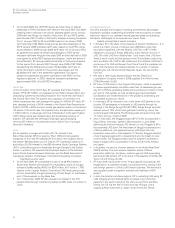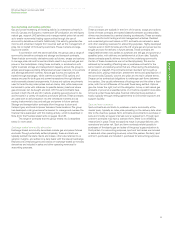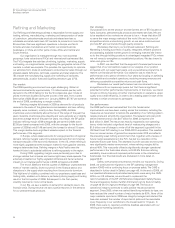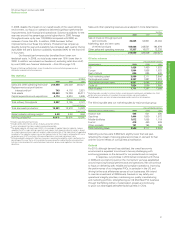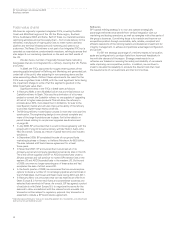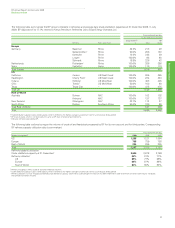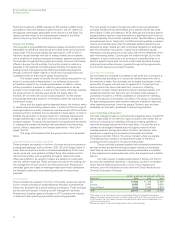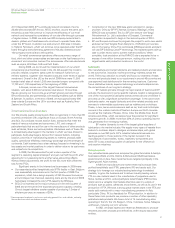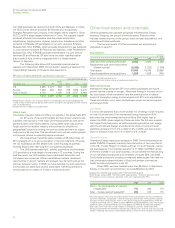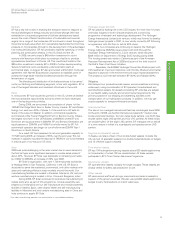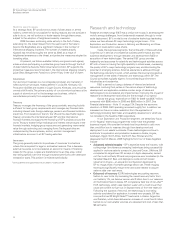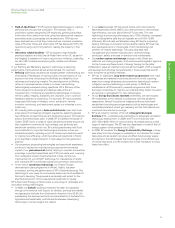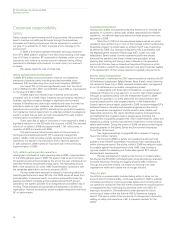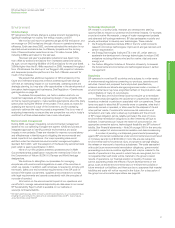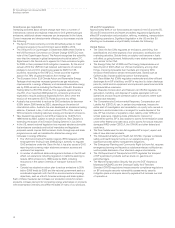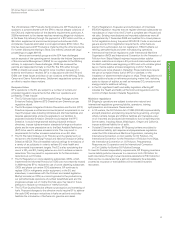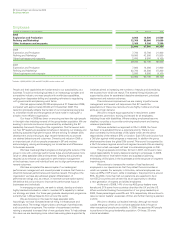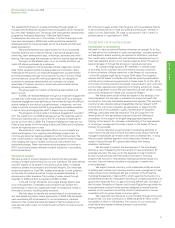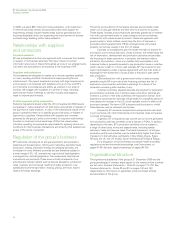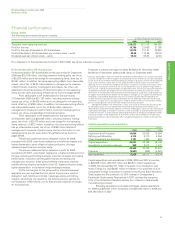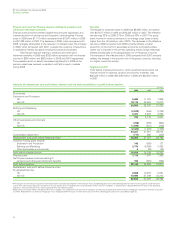BP 2009 Annual Report Download - page 46
Download and view the complete annual report
Please find page 46 of the 2009 BP annual report below. You can navigate through the pages in the report by either clicking on the pages listed below, or by using the keyword search tool below to find specific information within the annual report.
44
BP Annual Report and Accounts 2009
Business review
Maritime security issues
At a strategic level, BP avoids known areas of pirate attack or armed
robbery; where this is not possible for trading reasons and we consider it
safe to do so, we will continue to trade vessels through these areas,
subject to the adoption of heightened security measures.
2009 has seen continuing pirate activity in the Gulf of Aden,
extending into the Indian Ocean (from the east coast of Somalia to
beyond the Seychelles) and a significant increase in the number of
international shipping incidents. The number of vessels actually
hijacked has remained roughly the same as 2008, as a result of
heightened awareness to the threat, and protective measures adopted by
transiting ships.
At present, we follow available military and government agency
advice and are participating in protective group transits through the Gulf
of Aden Maritime Security Patrol Area transit corridor. BP supports the
protective measures recommended in the international shipping industry
guide Best Management Practices to Deter Piracy in the Gulf of Adena.
Aluminium
Our aluminium business is a non-integrated producer and marketer of
rolled aluminium products, headquartered in Louisville, Kentucky, US.
Production facilities are located in Logan County, Kentucky, and are jointly
owned with Novelis. The primary activity of our aluminium business is the
supply of aluminium coil to the beverage can business, which it
manufactures primarily from recycled aluminium.
Treasury
Treasury manages the financing of the group centrally, ensuring liquidity
sufficient to meet group requirements and manages key financial risks
including interest rate, foreign exchange, pension and financial institution
credit risk. From locations in the UK, the US and the Asia Pacific region,
Treasury provides the interface between BP and the international
financial markets and supports the financing of BP’s projects around the
world. Treasury trades foreign exchange and interest rate products in the
financial markets, hedging group exposures and generating incremental
value through optimizing and managing flows. Trading activities are
underpinned by the compliance, control, and risk management
infrastructure common to all BP trading activities.
Insurance
The group generally restricts its purchase of insurance to situations
where this is required for legal or contractual reasons. This is because
external insurance is not considered an economic means of financing
losses for the group. Losses are therefore borne as they arise, rather
than being spread over time through insurance premiums with attendant
transaction costs. This position is reviewed periodically.
aJointly published and supported by Industry bodies, including OCIMF.
Research and technology
Research and technology (R&T) has a critical role to play in addressing the
world’s energy challenges, from fundamental research through to wide-
scale deployment. BP’s model is one of selective technology leadership,
where we have chosen 20 major technology programmes – 10 in
Exploration and Production, seven in Refining and Marketing and three
focused on lower-carbon value chains.
Inside the business segments, the full breadth of these activities
is carried out in service of competitive business performance and new
business development, through research and development (R&D) or
acquisition of new technologies. The central R&T group provides
leadership and assurance for scientific and technological activities across
BP with a focus on having the right capability in critical areas, overseeing
the quality of BP’s major technology programmes, and illuminating the
potential of emerging science. External assurance is achieved through
the Technology Advisory Council, which advises the board and executive
management on the state of research and technology within BP. The
Council comprises typically eight to 10 world-leading and eminent
industrialists and academics.
R&D is carried out using a balance of internal and external
resources. Involving third parties in the various steps of technology
development and application enables a wider range of ideas and
technologies to be considered and implemented, improving the impact of
research and development activities and the leverage of our spend.
Across the group, expenditure on R&D for 2009 was $587 million,
compared with $595 million in 2008 and $566 million in 2007. See
Financial statements – Note 11 on page 134. Despite the economic
downturn of 2009, R&D spending remained roughly flat. In addition we
increased our focus on value realization from the application of
technology (including field trials), and capability development, which are
not included in the headline R&D expenditure.
In our Exploration and Production segment, we selectively focus
on 10 ‘flagship’ technology programmes which have the greatest
business impact. We consider that each has the potential to add more
than one billion boe to reserves through their development and
deployment in our assets worldwide. These technologies continue to
contribute to exploration and production success in Alaska, Angola,
Azerbaijan, Egypt, North Africa, the North Sea, Trinidad and the
deepwater Gulf of Mexico. 2009 highlights from four of these flagships
include:
•Advanced seismic imaging – BP’s expertise leads the industry, with
cutting-edge ‘simultaneous sweeping’ techniques being successfully
applied in onshore seismic surveys in Libya and Oman. Offshore, BP
completed its largest ever 3D surveys in Libya’s deepwater, carried
out the most northerly 3D seismic programme ever conducted (in the
Canadian Beaufort Sea), and deployed a wide azimuth towed
streamer in Angola – an acquisition configuration developed by
BP to image areas of complex geology below salt. These imaging
techniques significantly reduce time and costs needed to acquire
seismic data over vast areas.
•Enhanced oil recovery (EOR) technologies are pushing recovery
factors to new limits. By increasing the overall recovery factor from
our fields by 1%, we believe we can add 2 billion boe to our reserves.
At the Endicott field in Alaska, BP completed a field trial of its LoSalTM
EOR technology, which uses injection water with a much lower than
usual salt content to flush out or displace extra oil from the reservoir.
Following the success of this trial, the technology is now being
actively considered for application in several new projects. BP has
now performed 38 Bright Water™ treatments in Alaska, Argentina
and Pakistan, which have delivered an increase of more than 9 million
barrels to our recoverable volumes at a development cost of less than
$6 per barrel.


